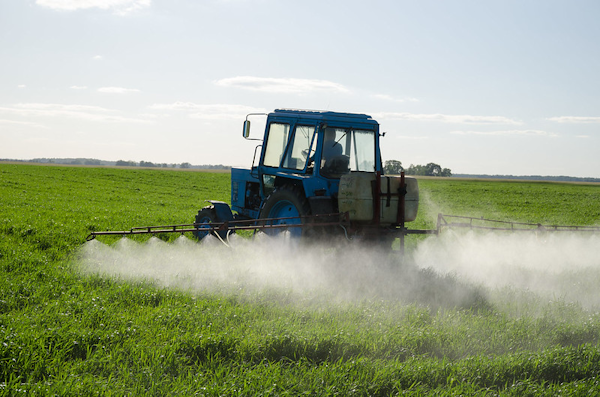SEJournal Online is the digital news magazine of the Society of Environmental Journalists. Learn more about SEJournal Online, including submission, subscription and advertising information.
 |
 |
| A tractor sprays a field in Orem, Utah. Despite federal regulations, pesticide exposure has long harmed people and the ecosphere. A major government database helps reporters track pesticide use. Photo: Aqua Mechanical via Flickr Creative Commons (CC BY 2.0). |
Reporter’s Toolbox: ‘Endangered’ USGS Pesticide Database Shows Wide Chemical Impact
By Joseph A. Davis
Environmental journalists can get good data on what pesticide chemicals are being sprayed where, … but if they don’t use it, they may lose it. It’s endangered.
More on that in a moment. But first, if you didn’t get the memo: Pesticides are a huge national environmental health issue. Have been for many decades.
Today, they are still harming people and the ecosphere, despite what passes for federal regulation.
And yes, the people most harmed are often those most powerless to protect themselves.
Farmworkers are exposed more than other population groups. Schoolchildren who have recess near sprayed fields don’t know what chemicals are drifting toward them. So are the farmers whose livelihood often depends on using agricultural chemicals.
But the pesticides that kill weeds and plant-eating insects can often harm nontarget insects, which may then be eaten by birds. Scientists have found that many insect populations, some beneficial, are declining nationally and globally.
And other scientists are worried that insect decline is leading to a decline in bird populations — whether the birds are being starved or poisoned.
Data cut, reversed
The U.S. Geological Survey maintains the database mentioned at the start of this Toolbox. It’s called the Pesticide National Synthesis Project.
You will not get data as useful as that of the PNSP from the Agriculture Department or the U.S. Environmental Protection Agency. Sure, both have some regulatory responsibility, but they bring with it political pressure that obscures data.
The USGS was about to cut back
the PNSP drastically, reporting on
way fewer chemicals less frequently.
The USGS, by contrast, is a science-only agency, which gives its data more usefulness and integrity. But recently, the USGS was about to cut back the PNSP drastically, reporting on way fewer chemicals less frequently.
Then this year it reversed those cuts, and it seems to be restoring the program. The PNSP at its zenith reported on over 400 chemicals annually. Now, we are happy to hear from Undark’s Sara Talpos that the USGS is planning to restore the program to its former scope and frequency.
Where the data comes from
Now we have to quibble. What you get from PNSP is not “data,” but estimates. The estimates are produced by a contractor, which gets them using standard survey techniques — asking farmers what they are spraying. Statistical sampling techniques give a probabilistic estimate of accuracy.
But look on the bright side: The data goes down to the country level, which is a pretty fine resolution.
Plus, the PNSP is updated every year and goes back to 1992. It includes more pesticides than any other assessment we know of. It even includes discontinued organochlorine pesticides, which it gets by sampling streambed sediment and fish tissue. And it’s all presented with a national-scale map for each pesticide.
The raw “data” can actually be downloaded free online. There’s no search engine, but the data is indexed by chemical and location.
How to use the data smartly
If there’s one quirk to this data it is that it’s water-focused, because that’s the USGS’s scientific focus — ground and surface water both. We suspect that it is less spot-on for concerns like aerosol drift.
The questions you ask this data to help answer, of course, will depend on your particular journalistic concerns.
It will be more meaningful once you start overlaying it with other mappable data, about things like crop production, demographics, watersheds, poisoning incidence or seasonality. Titrate it against other pesticide data like that from the USDA’s National Census of Agriculture.
As always with data projects, we encourage journalists to groundtruth everything possible — for instance, talk to experts at your state’s agricultural colleges and research institutions — and to do the additional shoe-leather reporting needed to explain the data’s human impact.
[Editor's Note: For more on pesticides, see Toolboxes on a U.S. Environmental Protection Agency pesticide database and on pesticide data for food and ag reporting, plus TipSheets about pesticides on lawns and on food, an Inside Story Q&A about covering the pesticide industry and a Backgrounder on pesticide regulation. Also, be sure to check out our latest EJToday headlines on pesticides and our Topic on the Beat: Agriculture page, with top agriculture stories from SEJournal and agriculture headlines from EJToday.]
Joseph A. Davis is a freelance writer/editor in Washington, D.C. who has been writing about the environment since 1976. He writes SEJournal Online's TipSheet, Reporter's Toolbox and Issue Backgrounder, and curates SEJ's weekday news headlines service EJToday and @EJTodayNews. Davis also directs SEJ's Freedom of Information Project and writes the WatchDog opinion column.
* From the weekly news magazine SEJournal Online, Vol. 9, No. 27. Content from each new issue of SEJournal Online is available to the public via the SEJournal Online main page. Subscribe to the e-newsletter here. And see past issues of the SEJournal archived here.













 Advertisement
Advertisement 



